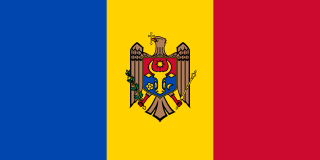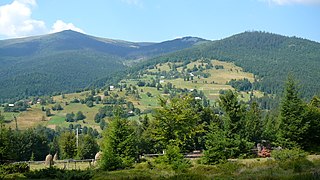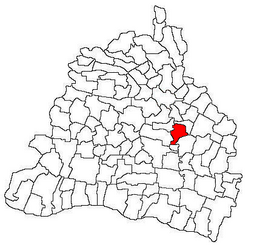
Moldova, officially the Republic of Moldova, is a landlocked country in Eastern Europe. It is bordered by Romania to the west and Ukraine to the north, east, and south. The capital city is Chișinău.

Romania is a country located at the crossroads of Central, Eastern, and Southeastern Europe. It borders with Bulgaria to the south, Ukraine to the north, Hungary to the west, Serbia to the southwest, and Moldova to the east and has its opening to the Black sea. It has a predominantly temperate-continental climate. With a total area of 238,397 square kilometres, Romania is the 12th-largest country in Europe and the 7th most populous member state of the European Union, having approximately 20 million inhabitants. Its capital and largest city is Bucharest. Other major urban areas include: Cluj-Napoca, Timișoara, Iași, Constanța, Craiova, Brașov, and Galați.

Romanian is a Balkan Romance language spoken by approximately 24–26 million people as a native language, primarily in Romania and Moldova, and by another 4 million people as a second language. According to another estimate, there are about 34 million people worldwide who can speak Romanian, out of which 30 million speak it as a native language. It is an official and national language of both Romania and Moldova and is one of the official languages of the European Union.

Transylvania is a historical region which is located in central Romania. Bound on the east and south by its natural borders, the Carpathian mountain range, historical Transylvania extended westward to the Apuseni Mountains. The term sometimes encompasses not only Transylvania proper, but also parts of the historical regions of Crișana and Maramureș, and occasionally the Romanian part of Banat.

Bucharest is the capital and largest city of Romania, as well as its cultural, industrial, and financial centre. It is located in the southeast of the country, at 44°25′57″N26°06′14″E, on the banks of the Dâmbovița River, less than 60 km (37.3 mi) north of the Danube River and the Bulgarian border.

The Carpathian Mountains or Carpathians are a range of mountains forming an arc throughout Central and Eastern Europe. Roughly 1,500 km (932 mi) long, it is the third-longest European mountain range after the Urals with 2,500 km (1,553 mi) and the Scandinavian Mountains with 1,700 km (1,056 mi). The range stretches from the far eastern Czech Republic (3%) in the northwest through Slovakia (17%), Poland (10%), Hungary (4%) and Ukraine (10%) Serbia (5%) and Romania (50%) in the southeast. The highest range within the Carpathians is known as the Tatra mountains in Slovakia, where the highest peaks exceed 2,600 m (8,530 ft). The second-highest range is the Southern Carpathians in Romania, where the highest peaks range between 2,500 m (8,202 ft) and 2,550 m (8,366 ft).

Nicolae Ceaușescu was a Romanian communist politician and leader. He was the general secretary of the Romanian Communist Party from 1965 to 1989 and hence the second and last Communist leader of Romania. He was also the country's head of state from 1967, serving as President of the State Council and from 1974 concurrently as President of the Republic until his overthrow and execution in the Romanian Revolution in December 1989, part of a series of anti-Communist and anti-Soviet Union uprisings in Eastern Europe that year.

Cluj-Napoca, commonly known as Cluj, is the fourth most populous city in Romania, and the seat of Cluj County in the northwestern part of the country. Geographically, it is roughly equidistant from Bucharest, Budapest and Belgrade. Located in the Someșul Mic river valley, the city is considered the unofficial capital to the historical province of Transylvania. From 1790 to 1848 and from 1861 to 1867, it was the official capital of the Grand Principality of Transylvania.

The Kingdom of Romania was a constitutional monarchy that existed in Romania from 26 March 1881 with the crowning of prince Karl of Hohenzollern-Sigmaringen as King Carol I, until 1947 with the abdication of King Michael I of Romania, and the Romanian parliament proclaiming Romania a people's republic.
Following the outbreak of World War II on 1 September 1939, the Kingdom of Romania under King Carol II officially adopted a position of neutrality. However, the rapidly changing situation in Europe during 1940, as well as domestic political upheaval, undermined this stance. Fascist political forces such as the Iron Guard rose in popularity and power, urging an alliance with Nazi Germany and its allies. As the military fortunes of Romania's two main guarantors of territorial integrity—France and Britain—crumbled in the Fall of France, the government of Romania turned to Germany in hopes of a similar guarantee, unaware that the then dominant European power had already granted its consent to Soviet territorial claims in a secret protocol of 1939's Molotov–Ribbentrop Pact.

The Socialist Republic of Romania refers to Romania under a Marxist-Leninist one-party communist regime that existed officially from 1947 to 1989. From 1947 to 1965, the state was known as the Romanian People's Republic. The country was a Soviet-aligned Eastern Bloc state with a dominant role for the Romanian Communist Party enshrined in its constitutions.

The Romanians are a Romance ethnic group and nation native to Romania, that share a common Romanian culture, ancestry, and speak the Romanian language, the most widespread spoken Balkan Romance language, which is descended from the Latin language. According to the 2011 Romanian census, just under 89% of Romania's citizens identified themselves as ethnic Romanians.

The Romania national football team represents Romania in international men's football competition, and is administered by the Romanian Football Federation. They are colloquially known as Tricolorii.

The Romanian Revolution was a period of violent civil unrest in Romania during December 1989 as a part of the Revolutions of 1989 that occurred in several countries. The Romanian Revolution started in the city of Timișoara and soon spread throughout the country, ultimately culminating in the show trial and execution of longtime Communist Party General Secretary Nicolae Ceaușescu and his wife Elena, and the end of 42 years of Communist rule in Romania. It was also the last removal of a Marxist-Leninist government in a Warsaw Pact country during the events of 1989, and the only one that violently overthrew a country's government and executed its leader.

The following outline is provided as an overview of and topical guide to Romania:

The Danube is Europe's second-longest river, after the Volga. It is located in Central and Eastern Europe.

A total of 41 counties, along with the municipality of Bucharest, constitute the official administrative divisions of Romania. They represent the country's NUTS-3 statistical subdivisions within the European Union and each of them serves as the local level of government within its borders. Most counties are named after a major river, while some are named after notable cities within them, such as the county seat.

The ongoing COVID-19 pandemic was confirmed to have reached Romania on 26 February 2020, with the first confirmed case in Gorj County.

















